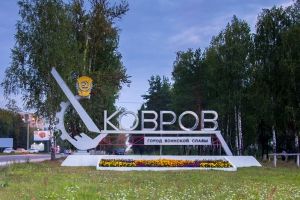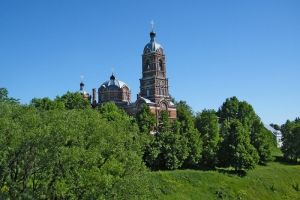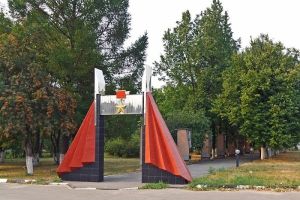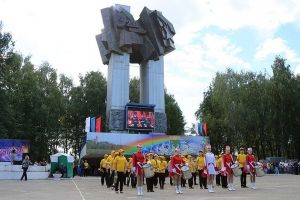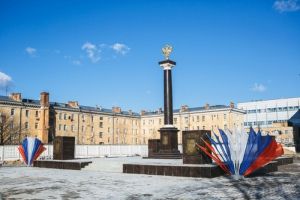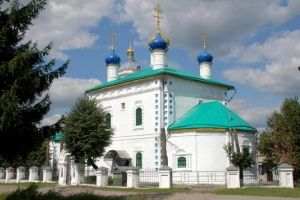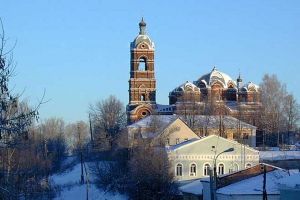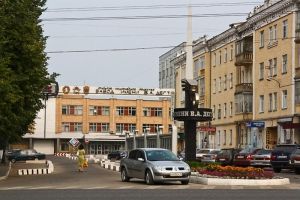Kovrov

Kovrov, the city of military glory, is the administrative center of Kovrov district and the second (after Vladimir) most populous city of the Vladimir region – 139, 280 people (2016). Kovrov is located on both banks of the Klyazma River, 64 km to the north-east of Vladimir. The city is a major railway junction on the Moscow- Nizhny Novgorod highway (250 km from Moscow to Kovrov), and has access to the M-7 "Volga" highway.
History
Although Kovrov received the status of the city only about 240 years ago, but its age is much more respectable. According to legend, in 1157 Prince Andrey Bogolyubsky, returning in winter from Suzdal to Starodub (now – the village of Klyazminsky Gorodok of Kovrov district), lost his way in the local forests and accidentally went to the Elifan-hunter’s hut. In honor of the Prince's miraculous rescue at Christmas, the wooden church of the Nativity of Christ was felled on the high bank of the Klyazma. According to the name of this temple, the village of Elifanovka located here began to be called the Rozhdestvenskoe (Christmas) village. In the 13th century, the village became part of the Starodub Principality.
Since the end of the 15th century, the Rozhdestvenskoe village passed into the possession of the princes Starodubsky-Kovrovy. The nickname of the princely family Starodubsky "Carpets" ("Kovry" – in Russian), according to legend, appeared with the light hand of Prince Dmitry Donskoy after the Kulikov battle in 1380: A.F. Starodubsky took out of the enemy camp an expensive khan carpet. It was this princely nickname that gave the new name to the Rozhdestvenskoe village – Kovrovo.
In 1567, the village of Kovrovo was donated by Prince I.S. Kovrov to Suzdal Spaso-Evfimiev monastery, and was in its patrimony for more than two centuries – until 1774. The area around the village was rich in deposits of limestone, the development of which for a long time was one of the main occupations of the Kovrovo residents. The buildings of the Spaso-Evfimiev and Pokrovsky monasteries in Suzdal, in particular, were erected of the Kovrovo’s white stone .
The village of Kovrovo had a reasonably favorable location on the shore of the navigable river Klyazma. In this place, there was a constant transportation through Klyazma on the busy Nizhny Novgorod trade route. Near the village of Kovrovo a trading terminal was established, where bread, fish, salt and other products, timber materials, handicraft products were brought from everywhere.
All this contributed to the acquisition of urban status by the village of Kovrovo. September 1, 1778, Empress Catherine II signed a decree on the establishment of the county town of Kovrov in the Vladimir vicegerency. In 1781, Kovrov already had its coat of arms as a city privilege. There is a legend that the tsar's governor Count Vorontsov was very fond of hunting hares in the Kovrov forests. It was he who proposed to depict these animals on the coat of arms of Kovrov next to the emblem of Vladimir – a lion.
Until the middle of the 19th century, Kovrov was a quiet provincial town. Industrial and commercial development of the city was facilitated by the construction of the Nizhny Novgorod railway, the movement on which was opened in 1862. At the same time, central railway workshops appeared in Kovrov, which became known in Russia. Freight and passenger wagons were created here, which awarded the highest awards at industrial exhibitions in Moscow and St. Petersburg at the end of the 19th century. In addition, the first sanitary trains was made in the Kovrov workshops. During the First World War, Kovrov was one of the points of formation of military-sanitary trains, each of which could take up to 400 wounded. In 1929, the railway workshops were converted to a repair and mechanical plant that carried out an order to repair imported excavators. In 1931 it became the Kovrov Excavator Plant, which was the first producer of domestic excavators "Kovrovets".
By the beginning of 20th century, Kovrov has already become a major industrial center of the Vladimir province with a population of 14,571 people (according to the results of the first All-Russian census of 1897). Along with the railway workshops there worked a large calico-weaving factory of the merchant I.A. Treumov, the iron foundry, numerous brick factories, a steam mill, a sawmill.
In 1916 the construction of the Kovrov machine-gun plant began. The present formation of the plant since 1918 was connected with the activity of the outstanding scientist V.G. Fedorov, the inventor of the world's first automaton, and the outstanding designer of automatic weapons V.A. Degtyarev, who supervised the design bureau of the plant until his death in 1949. The Memorial house- museum of VA. Degtyarev works in Kovrov , which exposition tells about his life and design activities. In 1949, the plant received the name of V.A. Degtyarev – "ZID" (today it produces not only defense, but also civilian products, for example, motorcycles). During the Great Patriotic War, the plant became the country's main enterprise for the production of anti-tank and other weapons for the front.
Kovrov during the Great Patriotic War
It is difficult to overestimate Kovrov's contribution to the Great Victory. 13 Heroes of the Soviet Union brought fame to Kovrov (L.V. Lopatin, I.S. Nosov, V.A. Burmatov, I.V. Pershutov, F.G. Konkov, V.I. Yastrebtsov, A.P. Generalov, P.K. Ranjev, V.G. Kabanov, P.S. Mashtakov, V.A. Zaevsky, A.P. Martynov, G.V. Provanov). All major enterprises of Kovrov were reoriented to military production. There were many hospitals in the city, since it was in the rear not far from the front line. In November 2011, by the decree of the President of the Russian Federation Kovrov was awarded the honorary title "City of Military Glory". In November 2013, on the square in front of the central gateway of OJSC "Plant named after V.A. Degtyarev " the stele "City of Military Glory" was installed.
In 2012, in connection with the assignment of this title to Kovrov, it was decided to adjust the coat of arms, taking into account the recommendations of the Heraldic Council under the President of the Russian Federation. Instead of a red ribbon, the coat of arms is now surrounded by a white and blue medal ribbon – a sign that in 1978 Kovrov was awarded the Order of the Red Banner of Labor. The gold tower crown with five prongs is an indicator of the status of the urban district. Crossed swords behind the crown symbolize the title given to Kovrov "City of military glory".
Economy
Modern Kovrov is a large industrial and scientific center of Russia, primarily in the defense industry, machine building and metalworking. Enterprises of these industries create over 70% of the total industrial output of the city, employing about 40% of the able-bodied urban population.
OJSC "Plant named after V.A. Degtyarev " (ZID) today is a diversified enterprise that produces not only defense products (small arms, anti-tank and missile weapons), but also motorcycles (motorcycles, motorized towing machines, scooters), soil cultivating equipment, food processing equipment, LED lamps. PJSC "Kovrov Mechanical Plant" (KMZ) is one of the leading enterprises of the Russian nuclear industry, since 2007 specializing in the manufacture of science-intensive and technically complex products – gas centrifuges (devices for separating uranium isotopes). The main specialization of OJSC "Kovrov Electromechanical Plant" (KEMZ) is hydraulic equipment, and the plant produces multi-functional mobile robotic complexes, used, in particular, for searching and remote disposal of explosive devices. In 2017 KEMZ started production of a new model line of Zetor Forterra tractors ("ANT 4135F") within the import substitution program. ARRI "Signal" is engaged in the development and production of defense hydraulics and electronics. Design department "Armature", since 1997 part of the State Space Research and Production Center named after M.V. Khrunichev, works in the field of development and production of aggregates and systems of ground infrastructure of rocket and space complexes, as well as pneumatic systems of carrier rockets.
Among the enterprises of light industry in Kovrov there are such well-known factories in Russia as "Sudar", which produces men's suits, "Ascona" - the largest manufacturer of orthopedic mattresses, etc. In the 1990s, the old pottery was revived. In 1993 the factory "Kovrov clay toy" was founded, which received the status of folk art.
Famous people
The names of many famous people in Russia are connected with the city of Kovrov. Famous weapons designers V.A. Degtyaryov (1879/1880-1949), V.G. Fedorov (1874-1966), G.S. Shpagin (1897-1952) lived and worked here. The native of Kovrov was I.M. Yatsunsky (1916-1983), a Soviet scientist, one of the creators of the first artificial Earth satellite, who was recognized as the founder of cosmic geodesy. In Kovrov were born: A.M. Kolesov (1834-1902), Russian portrait painter; S.K. Nikitin (1926-1973), a famous Soviet writer; A.P. Nepomnyashchiy (1968-2007), a popular bard, rock musician and others.
Sports resort of Dobrahrad
Today, the sports resort of Dobrograd is of interest to tourists and guests of Kovrov. It is located on the territory of one of the first private cities in Russia and is a unique object of public-private partnership. In September 2016, in Dobrograd, the VI International Sports Forum "Russia – a Sports Power" was held.
 Tourism portal of the
Tourism portal of the